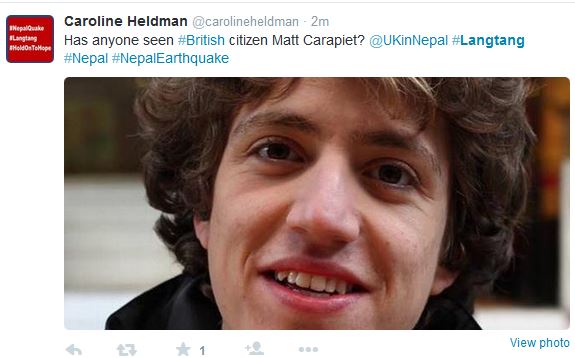29 April 2015
Landslides in Langtang during and after the Nepal earthquake
Posted by Dave Petley
Landslides in Langtang during and after the Nepal earthquake
The situation in the rural areas of Nepal after the earthquake is slowly, very slowly, becoming apparent. At the moment the clearest indications of serious problems are in Langtang – an area to north of Kathmandu that is popular with trekkers. A search on twitter using the term *langtang is chilling, with long lists of missing people:-
.
It is clear that landslides and avalanches have been a very significant factor in this area, both during the earthquake itself and in the aftermath. There is a very interesting account of this on the Facebook page of Robbie Barnett from Austin Lord, posted on the Modern Tibet Facebook page. I won’t repeat the whole post, but will highlight a couple of key sections:-
“The village of Langtang was the site of the largest single catastrophe, as the entirety of village was completely buried by an avalanche that came from thousands of feet above on the southern slopes of Langtang Lirung and Langtang II. Smaller settlements on the outskirts of Langtang, such as Chyamki, Thangsyap, and Mundu were also buried. It is impossible to determine exactly how many people died there, but the estimate is perhaps over 300 people in total. The handful of survivors, roughly twelve locals and two foreigners, walked down to Ghodatabela below after spending the night of the 25th in a cave – thus there is no one at Langtang itself. This avalanche is perhaps 2-3 kilometers wide, and is obstructing movement within the upper valley corridor. Currently two large groups are stranded above and below (due to several intensive and recurring landslides in the steep sections between Ghodatabela and Lama Hotel).”
“Below, at Ghodatabela (where I was located during the earthquake for roughly 55 hours following the event) several large landslides were triggered from all directions, the largest from perhaps 1,500 meters above just below the settlement, completely obstructing passage. The two guesthouses there were partially destroyed by large boulders, and the army checkpoint barracks collapsed during the earthquake. The night after the quake, there were two groups sleeping in separate fields by the river, keeping distance from ongoing landslides and rockfall that continued throughout the night.”
“Along the Trishuli River valley itself, there are other smaller landslides and reports of significant collapse at Mailung, Simle, and Archale. In Betrawati, Gerkhu, and Mhanegaun in bordering Nuwakot district several houses also collapsed, and there were casualties in all of these places.”
“The current data on total casualties following the earthquake here in Nepal is approaching 4,500. However, this is probably an underestimate considering that the estimate for the entire district of Rasuwa is 250, and there are at least 300 dead in the area around the village of Langtang alone. Across the board, it is still very difficult to determine exactly what has occurred in remote areas off the road system, as communication is down. Considered in terms of the percentage of total population, my sense is that Rasuwa has likely the third highest rate of fatality, behind Sindhupalchowk (at the epicenter of the major aftershock) and Dhading (closer to the center of the earthquake). Again, Langtang is probably one of the greatest single tragedies of this earthquake.”
“This is the latest news that I have as of 5pm on April 28th.”
This is the Langtang valley in question:
.
I assume that the landslide / avalanche at Langtang is the one that appeared in this tweeted image from early yesterday:

via Twitter
.
The Mountain Hydrology blog has a nice analysis of the potential source of this landslide.
And then yesterday came news of a post-seismic landslide or avalanche that struck the village of Ghodatabela, to which Austin Lord refers above. Information about this landslide is sketchy at present, but the Himalayan Times described it as follows:
“Not far from the quake’s epicenter, 250 people were feared missing after a mudslide and avalanche on Tuesday, district official Gautam Rimal said. Heavy snow had been falling near the village, Ghodatabela, and the ground may have been loosened by the quake. Rimal said officials received initial reports of the disaster by phone but then lost contact. The village, about a 12-hour walk from the nearest town, is along a popular trekking route, but it was not clear if the missing included trekkers.”
However, beyond this the picture remains worryingly unclear. These most recent events highlight the acute threat that landslides and avalanches will pose in the post-earthquake period, especially in the monsoon. There is an urgent need to start to systematically analyse the hazard. We hope that the EWF landslide guidelines will be a helpful first step
The village, about a 12-hour walk from the nearest town, is along a popular trekking route, but it was not clear if the missing included trekkers.
– See more at: http://www.thehimalayantimes.com/fullNews.php?headline=New%20mudslide%20hits%20Gorkha%20village%20near%20epicentre%20&NewsID=453075#sthash.ZHxlGRJQ.rYw0H6Jr.dpuf




 Dave Petley is the Vice-Chancellor of the University of Hull in the United Kingdom. His blog provides commentary and analysis of landslide events occurring worldwide, including the landslides themselves, latest research, and conferences and meetings.
Dave Petley is the Vice-Chancellor of the University of Hull in the United Kingdom. His blog provides commentary and analysis of landslide events occurring worldwide, including the landslides themselves, latest research, and conferences and meetings.
If you wish to help in this huge disaster you could donate your money to local organisations that are working in Kathmandu and Sindhupalchok districts. If you are unsure where your money goes, donate through https://www.w4.org/fr/project/aide-durgence-tremblement-de-terre-nepal/ . You will receive a report with the impact of your donation, and a little help will save many lives.
Hello Dear friends and trekkers Now Langtang region is totally rebuild you can trek any time you will find tea house every where.